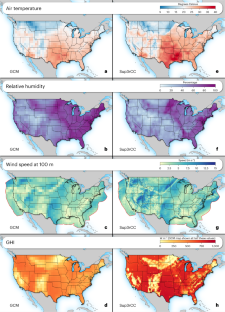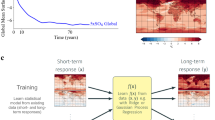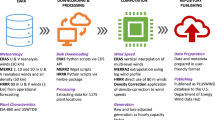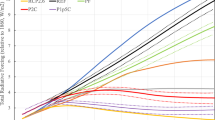Abstract
As renewable energy generation increases, the impacts of weather and climate on energy generation and demand become critical to the reliability of the energy system. However, these impacts are often overlooked. Global climate models (GCMs) can be used to understand possible changes to our climate, but their coarse resolution makes them difficult to use in energy system modelling. Here we present open-source generative machine learning methods that produce meteorological data at a nominal spatial resolution of 4 km at an hourly frequency based on inputs from 100 km daily-average GCM data. These methods run 40 times faster than traditional downscaling methods and produce data that have high-resolution spatial and temporal attributes similar to historical datasets. We demonstrate that these methods can be used to downscale projected changes in wind, solar and temperature variables across multiple GCMs including projections for more frequent low-wind and high-temperature events in the Eastern United States.
This is a preview of subscription content, access via your institution
Access options
Access Nature and 54 other Nature Portfolio journals
Get Nature+, our best-value online-access subscription
$29.99 / 30 days
cancel any time
Subscribe to this journal
Receive 12 digital issues and online access to articles
$119.00 per year
only $9.92 per issue
Buy this article
- Purchase on Springer Link
- Instant access to full article PDF
Prices may be subject to local taxes which are calculated during checkout







Similar content being viewed by others
Data availability
All data in this work are open-access and freely available to the public. The NSRDB, WTK and Sup3rCC data and models are publicly available via the Open Energy Data Initiative (OEDI) with Digital Object Identifiers: https://doi.org/10.25984/1810289 (NSRDB), https://doi.org/10.25984/1822195 (WTK) and https://doi.org/10.25984/1970814 (Sup3rCC)71,72,73. The HRRR is publicly available via Amazon Web Services at https://registry.opendata.aws/noaa-hrrr-pds/. The initial Sup3rCC data presented in this work have been assigned v.0.1.0.
Code availability
The Super-Resolution for Renewable Resource Data (sup3r) software is open-source and publicly available at https://github.com/NREL/sup3r and https://doi.org/10.5281/zenodo.7826915 (ref. 68). Examples of how to use the Sup3rCC models and access the data are included with the sup3r software here: https://github.com/NREL/sup3r/tree/main/examples/sup3rcc.
References
Zhou, E. & Mai, T. Electrification Futures Study: Operational Analysis of U.S. Power Systems with Increased Electrification and Demand-Side Flexibility (US National Renewable Energy Laboratory, 2021); https://www.nrel.gov/docs/fy21osti/79094.pdf
Xexakis, G. & Trutnevyte, E. Consensus on future EU electricity supply among citizens of France, Germany, and Poland: implications for modeling. Energy Strategy Rev. 38, 100742 (2021).
Steggals, W., Gross, R. & Heptonstall, P. Winds of change: how high wind penetrations will affect investment incentives in the GB electricity sector. Energy Policy 39, 1389–1396 (2011).
Brinkman, G. et al. The North American Renewable Integration Study: A U.S. Perspective (US National Renewable Energy Laboratory, 2021); https://www.nrel.gov/docs/fy21osti/79224.pdf
Boie, I., Fernandes, C., Frías, P. & Klobasa, M. Efficient strategies for the integration of renewable energy into future energy infrastructures in Europe–an analysis based on transnational modeling and case studies for nine European regions. Energy Policy 67, 170–185 (2014).
Sun, X., Zhang, B., Tang, X., McLellan, B. C. & Höök, M. Sustainable energy transitions in China: renewable options and impacts on the electricity system. Energies 9, 980 (2016).
Carvallo, J. et al. A Guide for Improved Resource Adequacy Assessments in Evolving Power Systems: Institutional and Technical Dimensions (Ernest Orlando Lawrence Berkeley National Laboratory, 2023); https://eta-publications.lbl.gov/sites/default/files/ra_project_-_final.pdf
Stenclik, D. et al. Redefining Resource Adequacy for Modern Power Systems (Energy Systems Integration Group, 2021); https://www.esig.energy/wp-content/uploads/2022/12/ESIG-Redefining-Resource-Adequacy-2021-b.pdf
Auffhammer, M., Baylis, P. & Hausman, C. H. Climate change is projected to have severe impacts on the frequency and intensity of peak electricity demand across the United States. Proc. Natl Acad. Sci. USA 114, 1886–1891 (2017).
Huang, J. & Gurney, K. R. Impact of climate change on U.S. building energy demand: sensitivity to spatiotemporal scales, balance point temperature, and population distribution. Clim. Change 137, 171–185 (2016).
Craig, M. T. et al. A review of the potential impacts of climate change on bulk power system planning and operations in the United States. Renew. Sustain. Energy Rev. 98, 255–267 (2018).
Bloomfield, H. C., Brayshaw, D. J., Shaffrey, L. C., Coker, P. J. & Thornton, H. E. Quantifying the increasing sensitivity of power systems to climate variability. Environ. Res. Lett. 11, 124025 (2016).
Yalew, S. G. et al. Impacts of climate change on energy systems in global and regional scenarios. Nat. Energy 5, 794–802 (2020).
Craig, M. T., Jaramillo, P., Hodge, B.-M., Nijssen, B. & Brancucci, C. Compounding climate change impacts during high stress periods for a high wind and solar power system in Texas. Environ. Res. Lett. 15, 024002 (2020).
Dowling, P. The impact of climate change on the European energy system. Energy Policy 60, 406–417 (2013).
Craig, M. T. et al. Overcoming the disconnect between energy system and climate modeling. Joule 6, 1405–1417 (2022).
Tapiador, F. J., Navarro, A., Moreno, R., Sánchez, J. L. & García-Ortega, E. Regional climate models: 30 years of dynamical downscaling. Atmos. Res. 235, 104785 (2020).
Pierce, D. W., Cayan, D. R. & Thrasher, B. L. Statistical downscaling using localized constructed analogs (LOCA). J. Hydrometeorol. 15, 2558–2585 (2014).
Wood, A. W., Leung, L. R., Sridhar, V. & Lettenmaier, D. P. Hydrologic implications of dynamical and statistical approaches to downscaling climate model outputs. Clim. Change 62, 189–216 (2004).
Kaczmarska, J., Isham, V. & Onof, C. Point process models for fine-resolution rainfall. Hydrol. Sci. J. 59, 1972–1991 (2014).
Vandal, T., Kodra, E. & Ganguly, A. R. Intercomparison of machine learning methods for statistical downscaling: the case of daily and extreme precipitation. Theor. Appl. Climatol. 137, 557–570 (2019).
Stengel, K., Glaws, A., Hettinger, D. & King, R. N. Adversarial super-resolution of climatological wind and solar data. Proc. Natl Acad. Sci. USA 117, 16805–16815 (2020).
Tran, D. T. et al. GANs enabled super-resolution reconstruction of wind field. J. Phys. Conf. Ser. 1669, 012029 (2020).
Kim, J., Lee, J. K. & Lee, K. M. Deeply-recursive convolutional network for image super-resolution. in IEEE Conference on Computer Vision and Pattern Recognition (CVPR) 1637–1645 (2016).
Hess, P., Drüke, M., Petri, S., Strnad, F. M. & Boers, N. Physically constrained generative adversarial networks for improving precipitation fields from Earth system models. Nat. Mach. Intell. https://doi.org/10.1038/s42256-022-00540-1 (2022).
Goodfellow, I. et al. Generative adversarial nets. In Proc. Advances in Neural Information Processing Systems Vol. 27 (eds Ghahramani, Z. et al.) (Curran Associates, Inc., 2014).
Di Luca, A., de Elía, R. & Laprise, R. Potential for small scale added value of RCM’s downscaled climate change signal. Clim. Dyn. 40, 601–618 (2013).
Flato, G. et al. in IPCC Climate Change 2013: The Physical Science Basis Ch. 9 (eds Stocker, T. F. et al.) (IPCC, Cambridge Univ. Press, 2013).
Yukimoto, S. et al. MRI MRI-ESM2.0 Model Output Prepared for CMIP6 C4MIP esm-ssp585 Version 20191108 (WDC Climate, 2019); https://doi.org/10.22033/ESGF/CMIP6.6811
EC-Earth Consortium (EC-Earth). EC-Earth-Consortium EC-Earth3 Model Output Prepared for CMIP6 CMIP esm-ssp585, Version 20200310 (Earth System Grid Federation, 2019); https://doi.org/10.22033/ESGF/CMIP6.4700
Kao, S.-C. et al. The Third Assessment of the Effects of Climate Change on Federal Hydropower (OSTI, 2022); https://www.osti.gov/biblio/1887712/
Martinez, A. & Iglesias, G. Climate change impacts on wind energy resources in North America based on the CMIP6 projections. Sci. Total Environ. 806, 150580 (2022).
Sengupta, M. et al. The National Solar Radiation Data Base (NSRDB). Renew. Sustain. Energy Rev. 89, 51–60 (2018).
Draxl, C., Clifton, A., Hodge, B.-M. & McCaa, J. The Wind Integration National Dataset (WIND) Toolkit. Appl. Energy 151, 355–366 (2015).
James, E. P. et al. The High-Resolution Rapid Refresh (HRRR): an hourly updating convection-allowing forecast model. Part II: forecast performance. Weather Forecast. 37, 1397–1417 (2022).
Jafari, S., Sommer, T., Chokani, N. & Abhari, R. S. Wind resource assessment using a mesoscale model: the effect of horizontal resolution. in Proc. ASME Turbo Expo 2012: Turbine Technical Conference and Exposition (eds Bainier, F. et al.) 987–995 (American Society of Mechanical Engineers Digital Collection, 2013).
Perez, R., David, M. & Hoff, T. E. in Foundations and Trends in Renewable Energy (eds Norton, B. et al.) 1–44 (Now Publishers Inc., 2016).
Kolmogorov, A. N. Dissipation of energy in the locally isotropic turbulence. Proc. Math. Phys. Sci. 434, 15–17 (1991).
Holttinen, H. et al. Design and Operation of Power Systems with Large Amounts of Wind Power: Final Summary Report, IEA WIND Task 25, Phase Four 2015–2017 (VTT Technical Research Centre of Finland, 2019); https://doi.org/10.32040/2242-122X.2019.T350
Dobos, A. P. PVWatts Version 5 Manual (OSTI, 2014); https://www.osti.gov/biblio/1158421
Gueymard, C. A. REST2: high-performance solar radiation model for cloudless-sky irradiance, illuminance, and photosynthetically active radiation–validation with a benchmark dataset. Sol. Energy 82, 272–285 (2008).
Maxwell, E. L. A Quasi-Physical Model for Converting Hourly Global Horizontal to Direct Normal Insolation (OSTI, 1987); https://www.osti.gov/biblio/5987868
Olea, R. A. in Geostatistics for Engineers and Earth Scientists (ed. Olea, R. A.) 67–90 (Springer, 1999).
Stull, R. Wet-bulb temperature from relative humidity and air temperature. J. Appl. Meteorol. Climatol. 50, 2267–2269 (2011).
Gelaro, R. et al. The modern-era retrospective analysis for research and applications, version 2 (MERRA-2). J. Clim. 30, 5419–5454 (2017).
Atmospheric Radiation Measurement (ARM). Data Quality Assessment for ARM Radiation Data (QCRADBRS1LONG). 2015-01-01 to 2021-12-31, Southern Great Plains (SGP) Central Facility, Lamont, OK (C1) (eds Shi, Y. & Riihimaki, L.) (ARM Data Center, 1993); https://doi.org/10.5439/1027745
Brinkman, G. et al. The North American Renewable Integration Study (NARIS): A U.S. Perspective (OSTI, 2021); https://www.osti.gov/biblio/1804701
Peacock, J. A. Two-dimensional goodness-of-fit testing in astronomy. Mon. Not. R. Astron. Soc. 202, 615–627 (1983).
Novacheck, J. et al. The Evolving Role of Extreme Weather Events in the U.S. Power System with High Levels of Variable Renewable Energy (OSTI, 2021); https://www.osti.gov/biblio/1837959
IPCC Climate Change 2023: Synthesis Report Contribution of Working Groups I, II and III to the Sixth Assessment Report of the Intergovernmental Panel on Climate Change (eds Lee, H. & Romero, J.) 184 (IPCC, 2023).
Ralston Fonseca, F. et al. Climate-induced tradeoffs in planning and operating costs of a regional electricity system. Environ. Sci. Technol. 55, 11204–11215 (2021).
Avery, C. W. et al. in Impacts, Risks, and Adaptation in the United States: Fourth National Climate Assessment Vol. II (eds Reidmiller, D. R. et al.) 1413–1430 (US Global Change Research Program, 2018).
Draxl, C., Hodge, B. M., Clifton, A. & McCaa, J. Overview and Meteorological Validation of the Wind Integration National Dataset Toolkit (OSTI, 2015); https://www.osti.gov/biblio/1214985
Hassanaly, M., Glaws, A., Stengel, K. & King, R. N. Adversarial sampling of unknown and high-dimensional conditional distributions. J. Comput. Phys. 450, 110853 (2022).
Wootten, A., Terando, A., Reich, B. J., Boyles, R. P. & Semazzi, F. Characterizing sources of uncertainty from global climate models and downscaling techniques. J. Appl. Meteorol. Climatol. 56, 3245–3262 (2017).
Karnauskas, K. B., Lundquist, J. K. & Zhang, L. Southward shift of the global wind energy resource under high carbon dioxide emissions. Nat. Geosci. 11, 38–43 (2018).
Cohen, J. et al. Divergent consensuses on Arctic amplification influence on midlatitude severe winter weather. Nat. Clim. Chang. 10, 20–29 (2020).
Voigt, A. et al. Clouds, radiation, and atmospheric circulation in the present-day climate and under climate change. WIREs Clim. Change 12, e694 (2021).
Springenberg, J. T., Dosovitskiy, A., Brox, T. & Riedmiller, M. A. Striving for simplicity: the all convolutional net. in CoRR Vol. abs/1412.6806 (2014).
He, K., Zhang, X., Ren, S. & Sun, J. Deep residual learning for image recognition. in Proc. IEEE Conference on Computer Vision and Pattern Recognition 770–778 (2016).
He, K., Zhang, X., Ren, S. & Sun, J. Identity mappings in deep residual networks. in Proc. Computer Vision–ECCV 2016 (eds Leibe, B. et al.) 630–645 (Springer International Publishing, 2016).
Shi, W. et al. Is the deconvolution layer the same as a convolutional layer? Preprint at arXiv http://arxiv.org/abs/1609.07009 (2016).
Federal Aviation Administration. in Pilot’s Handbook of Aeronautical Knowledge Ch. 4 (FAA, US Government, 2023).
Ho, C. K., Stephenson, D. B., Collins, M., Ferro, C. A. T. & Brown, S. J. Calibration strategies: a source of additional uncertainty in climate change projections. Bull. Am. Meteorol. Soc. 93, 21–26 (2012).
Xu, Z., Han, Y., Tam, C.-Y., Yang, Z.-L. & Fu, C. Bias-corrected CMIP6 global dataset for dynamical downscaling of the historical and future climate (1979–2100). Sci. Data 8, 293 (2021).
Lehner, F., Nadeem, I. & Formayer, H. Evaluating skills and issues of quantile-based bias adjustment for climate change scenarios. Adv. Stat. Climatol. Meteorol. Oceanogr. 9, 29–44 (2023).
Touma, J. S. Dependence of the wind profile power law on stability for various locations. J. Air Pollut. Control Assoc. 27, 863–866 (1977).
Benton, B. N., Buster, G., Glaws, A. & King, R. Super-resolution for renewable resource rata (sup3r) v.0.1.0. Zenodo https://doi.org/10.5281/zenodo.7826915 (2023)
Maclaurin, G. et al. The Renewable Energy Potential (reV) Model: A Geospatial Platform for Technical Potential and Supply Curve Modeling (US National Renewable Energy Laboratory, 2019); https://www.nrel.gov/docs/fy19osti/73067.pdf
Buster, G. et al. The Renewable Energy Potential (reV) Model. v.0.8.0. Zenodo https://doi.org/10.5281/zenodo.8247528 (2023).
Sengupta, M., Habte, A., Xie, Y., Lopez, A. & Buster, G. National Solar Radiation Database (NSRDB) (US National Renewable Energy Laboratory, 2018); https://data.openei.org/submissions/1
Maclaurin, G., Draxl, C., Hodge, B.-M. & Rossol, M. Wind Integration National Dataset (WIND) Toolkit (US National Renewable Energy Laboratory, 2014); https://data.openei.org/submissions/2
Buster, G., Benton, B., Glaws, A. & King, R. Super-Resolution for Renewable Energy Resource Data with Climate Change Impacts (Sup3rCC) (US National Renewable Energy Laboratory, 2023); https://data.openei.org/submissions/5839
Acknowledgements
We thank A. Lopez, T. Mai, P. Lamers, M. Ruth, D. Bilello, M. Mooney, D. Arent, G. Porro, E. Laidlaw and Z. Goff-Eldredge for their thoughtful reviews of an earlier draft. We also thank B. Roberts for developing Fig. 1 and M. Heine, R. Olson, J. Gu and N. Taverna for making the Sup3rCC data available via OEDI. This work was authored by the National Renewable Energy Laboratory, operated by Alliance for Sustainable Energy, LLC, for the US Department of Energy (DOE) under Contract No. DE-AC36-08GO28308. Funding provided by the DOE Grid Deployment Office (GDO) (award no. 38843), the DOE Office of Advanced Scientific Computing Research (ASCR) (field work proposal no. ERW1579), the DOE Solar Energy Technologies Office (SETO) (award no. 38421) and the Laboratory Directed Research and Development (LDRD) programme at the National Renewable Energy Laboratory. The research was performed using computational resources sponsored by the DOE Office of Energy Efficiency and Renewable Energy and located at the National Renewable Energy Laboratory. The views expressed in the article do not necessarily represent the views of the DOE or the US Government. The US Government retains and the publisher, by accepting the article for publication, acknowledges that the US Government retains a nonexclusive, paid-up, irrevocable, worldwide license to publish or reproduce the published form of this work, or allow others to do so, for US Government purposes.
Author information
Authors and Affiliations
Contributions
G.B. developed software, developed methods, trained models, produced data and wrote the paper. B.N.B. developed software, advised on methods and wrote the paper. A.G. and R.N.K. advised on methods and wrote the paper.
Corresponding author
Ethics declarations
Competing interests
The authors declare no competing interests.
Peer review
Peer review information
Nature Energy thanks Bianca Zadrozny and the other, anonymous, reviewer(s) for their contribution to the peer review of this work.
Additional information
Publisher’s note Springer Nature remains neutral with regard to jurisdictional claims in published maps and institutional affiliations.
Supplementary information
Supplementary Information
Supplementary Figs. 1–23 and Tables 1–10.
Rights and permissions
Springer Nature or its licensor (e.g. a society or other partner) holds exclusive rights to this article under a publishing agreement with the author(s) or other rightsholder(s); author self-archiving of the accepted manuscript version of this article is solely governed by the terms of such publishing agreement and applicable law.
About this article
Cite this article
Buster, G., Benton, B.N., Glaws, A. et al. High-resolution meteorology with climate change impacts from global climate model data using generative machine learning. Nat Energy (2024). https://doi.org/10.1038/s41560-024-01507-9
Received:
Accepted:
Published:
DOI: https://doi.org/10.1038/s41560-024-01507-9



